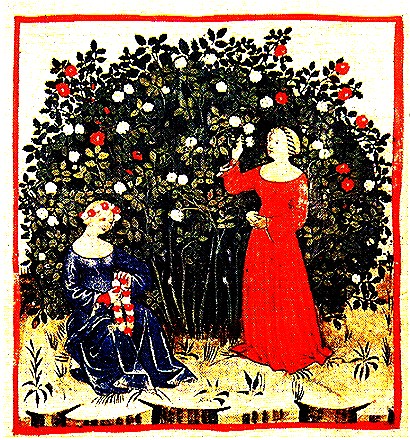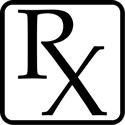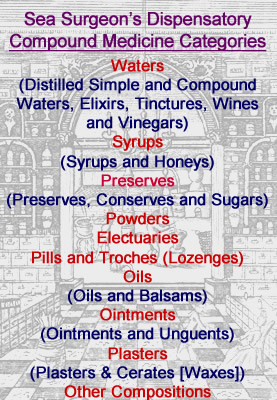
Sea Surgeon's Dispensatory: 1 2 3 4 5 6 7 8 9 10 11 12 13 14 15 16 17 18 19 20 21 22 23 24 25 Next>>
The Sea Surgeon's Dispensatory, Page 13
Sea Surgeon's Dispensatory Sources

Ship in Dry Dock (17th Century)
The Sea Surgeon's Dispensatory is composed of the medicines found in John Woodall's The Surgions Mate, John Moyle's The Sea Chyrurgion and the Bill of Sale made out by John Tweedy for the privateering ship Revenge, although they didn't always refer to the medicines in the same way.
As a result, each medicine in the Sea Surgeon's Dispensatory will list the source where it is used colored by author - green for Woodall, blue for Moyle and yellow for Tweedy - as well as the name that the medicine is called by in that particular source. In addition, if the source is John Woodall's book, it will also indicate whether it was one he specifically identified being included in the medicine chests he made for the East India Company, (appearing as Woodall-Chest: when it is included in the chest vs. just Woodall:).
There are also 29 compound medicines described in detail by John Moyle in his book. He gives complete information on their makeup and some information on their use. These will be indicated as Moyle-Composition while those not Moyle. Nearly all of these medicines are exclusive to Moyle's book (although some of these medicines with similar names do appear in the dispensatories), so the recipe and use for them will be taken directly from there.
However most sea surgeons would probably not make the compound medicines which are listed in their chests. One purpose of the chest was to hold medicines too complex or time consuming to be made at sea. The chest was purchased stocked on land where apothecary shops which were better equipped and versed in the preparation of such medicines and could make them up, bottle them and send them in the chest complete. Nevertheless, like most period dispensatories, the recipe is included. The sea surgeon's books do list recipes for some medicines in their main text and sometimes enourage the reader to make the medicines themselves, so some medicine composition did occur at sea.
When describing the use of the medicines, the Sea Surgeon's Dispensatory will generally give information from two different sources if it is available to help give a more balanced perspective on the medicine. (Some of their opinion's differ quite widely.) The first description will be either from Woodall's book or military surgeon Thomas Brugis's Vade mecum when they are found in either of those two sources. The second explanation will come from the other period and near dispensatories mentioned previously.
Sea Surgeon's Dispensatory Humors
Where it is known, the humoral rating for medicines will be given. They will be labeled hot, cold, dry and moist and, if known, the degree of the humoral strength will be indicated as a 1,2,3 or 4 where 1 indicates weak humoral strength and 4 indicates strong. These will nearly always be given for simple medicines and sometimes given for compound medicine that are based upon a single simple.

Roses, From Theatricum of the Casanatense Library (14th c.) The entry explains
that roses are "Cold in the second degree, dry in the third."
The humoral information will come primarily from Thomas Brugis' 1689 Vade Mecum, Nicholas Culpeper's 1720 A Pharmacopoeia Londeniis, Jean de Renou's 1657 A Medical Dispensatory and John Woodall's book. A few entries not found elsewhere will come from other sources when they can be found. (Among them, an interpretation of illuminated medieval books grouped together as Tacuinum Sanatalis - a handbook on health and well being - found on the webpage godecookery.com as well as at wikimedia commons.
The humoral information these sources provide varies somewhat, with differences in degrees and even sometimes in properties between the sources. For example, Brugis lists wormwood as 'hot and dry 3rd degree'1 while Culpeper lists it as 'hot & dry - 2nd or 3rd degree'2.
None of the sources consistently include the degree of the property; sometimes they only note that a medicine heats, cools, dries or moistens without indicating to what degree. Other times they give vague descriptors such as 'somewhat hot & dry'3 or "of a cold nature"4. In addition to the standard terms, Jean de Renou's book also uses other words (and their variants) such as 'madefy' for moisten5, 'calefy' for hot6, 'siccate' for dry7 and 'refrigerate' for cool8.
For the sake of clarity, the terms used in the Sea Surgeon's Dispensatory will always include the standardized hot, cold, dry and moist with degrees included when they are known. Where other terms are used in the text, they will be included in parenthesis for reference and footnoted to indicate which text they came from.
1 Thomas Brugis, Vade mecum: or, A Companion For a Chirurgion", 1689, p.146; 2 Nicholas Culpeper, Pharmacopœia Londinesis, p. 17; 2 'Sarsaparilla', Culpeper, p. 12; 4 'Hyacinth', Jean de Renou, A Medicinal Dispensatory, p. 415; 5 'For example, see 'Quicksilver', de Renou, p. 409; 6 'For example, see 'Guiacum', de Renou, p. 288; 7,8 'For example, see 'Currants', de Renou, p. 386;
Sea Surgeon's Dispensatory Compound Recipes

Rx, by Nevit Dilman
Since compound medicines include the combination and/or chemical processing of simples, the recipe (also called a 'receipt') for those medicines will be included before the description, listed after the descriptor Rx:.
Rx (sometimes shown as Rx or as the symbol seen at right) comes from the Latin word for recipe, the imperative form of recipere, "to take" or "take thus". It originated in medieval manuscripts as an abbreviation of the Latin verb.1 While these recipes are found in the dispensatories of the time, they were taken by the dispensatory authors from the official Pharmacopoeias.
1 "Medical prescription", wikipedia.org, gathered 6/4/15
Sea Surgeon's Dispensatory Organization
Not surprisingly, the medicinal books of the late seventeenth and early eighteenth centuries were organized in a manner similar to the London and Edinburgh pharmacopoeias upon which they were based. The pharmacopoeias broadly divided medicines into simples, compounds and chemical medicines. These three main categories were then further subdivided.

Latin Plant Part Names Used in Dispensatory
Image Artist: William Curtis
The Botanical Magazine, Pl. 9, Vol.1 (1787)
Simples were broadly divided into plant, animal and mineral subcategories. The largest subcategory was the plant-based simples, which lead to the creation of even finer subdivisions within the various dispensatories. For example, Nicholas Culpeper splits plants into Roots, Barks, Herbs and their Leaves, Flowers, Fruits and their Buds, Seeds or Grains, and Tears, Liquors and Rosins.
Of course Culpeper was dealing with over a thousand simples where the Sea Surgeon's Dispensatory contains only 178: 141 plant-based simples, 23 mineral-based simples, 14 animal-based simples. Rather than overcomplicate the organization of simples, the Sea Surgeon Dispensatory will only organize them into plants, animals and minerals.
Although not formally listed, the reader will find a certain amount of natural segregation of different plant parts based on their names. The most notable of these are Flores (Latin for Flowers), Radix (roots) and Semen (seeds). The full list of Latin plant parts that appear in the Plant section of the Sea Surgeon's Dispensatory can be seen in the chart at left.
Compound medicines - those made by combining simples and performing simple operations on them like distillation - are the largest category of medicine found in the Sea Surgeon's Dispensatory, containing 223 medicinals. This is to be expected given the short shelf life of simple plants and animals. The compounds are typically subdivided into categories which are based on their consistency.
Culpeper sometimes also defines the compound subcategories according their method of production. For example, he splits Waters into

Compound Medicine Categories Used in Dispensatory
Image From The Friendly Physician, by Francis Spilbury
From the Wellcome Collection (1773)
Simple Distilled Waters, Compound Distilled Waters and Spirits, Tinctures, Physical Wines and Physical Vinegars and Decoctions. Robert James separates them similarly with slightly more logical gradations. His sub-categories include Simple Waters, Compound Waters, Distilled Waters, Waters by Infusion and Vinegars, Tinctures, and Wines. (Unlike Culpeper, James' book used a later edition of the London pharmacopoeia and included information from the Edinburgh pharmacopoeia. This may explain the differences.)
In a few cases, Culpeper also divides compound medicines by their function; he splits Syrups into regular Syrups, Purging Syrups and Syrups made with Vinegar and Honey. James does not do this.
For simplicity, the compound categories will be divided only by consistency in the Sea Surgeon's Dispensatory. The categories include Waters (62 items), Syrups (29 items), Preserves (6 items), Powders (14 items), Electuaries (23 items), Pills and Troches [Lozenges] (15 items), Oils (27 items), Ointments (26 items), Plasters (21 items), and Other Compositions (2 items). These categories focus on the medicine's consistency, ignoring the method of production and function. To see how Culpeper and James subcategories fit into the scheme used by the Sea Surgeon's Dispensatory, see the chart at right. Note that although they are not grouped by these subtypes, the names of medicines often indicate the subtype.
Chemical medicines are the smallest group of medicines. Culpeper simply divided them into oils and preparations. James (who wrote almost seventy-five years later than Culpeper, when chemical medicines were more accepted by medicine) divides them into Chemically Distilled Oils, Chemical Extracts and Resins, Essential and Fixed Salts, Chemical Preparations of Animals, Chemical Preparations of Minerals, Preparations of Sulphur, Preparations of Metals and Preparations of Metalline Minerals. Since the Sea Surgeon's Dispensatory contains only 47 Chemical Medicines, they will all be put into one category.
Sea Surgeon's Dispensatory Index
The Sea Surgeon's Dispensatory Contains 450 total medicines. For reference, they are indexed here in alphabetical order. Those with a * have been scientifically studied and found to be effective in treating certain health problems which is discussed at the end of the entry. (Note that this is not medical advice and the author is not a medical professional.)
| - H & I - | |
|---|---|
| Hiera Picra Simple | Hordeum (Barley) |
| Hordeum Gallicum (French Barley) | Hyacinthus |
| Hyssopi (Hyssop) | Icthyocolla |
| Ivory |
| - V, W & Z - | |
|---|---|
| Verjuice (Crab Apple Juice) | Vinum Benedictum |
| Vitriolum (Blue Vitriol) | Vitriolum Album (White Coperas, Zinc Sulfate) |
| White Causticke | Zinziber (Ginger)* |

